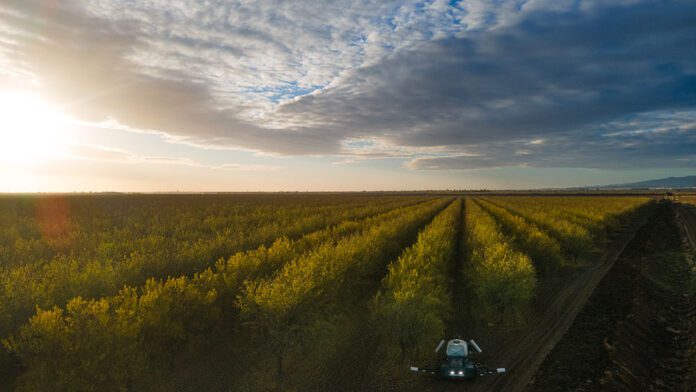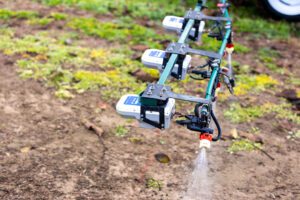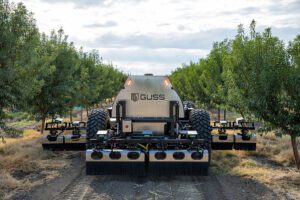
When the Giacomazzis sold what was California’s oldest dairy herd in 2019, they had a history of conservation and sustainability practices that even garnered them the Leopold Conservation Award. They followed the same philosophy as they moved into almond production near Hanford, including use of PTx Trimble herbicide spot-spraying technology that targets weeds and significantly reduces the amount of product applied.
“Environmental solutions have to be the most profitable solutions, or nobody will adopt them,” said Dino Giacomazzi, who has about 700 acres of almonds. “I try to design systems that are the most profitable and most environmentally beneficial at the same time. And there’s no doubt of the value of a reduction of 70% of chemicals used.”
Mike Faria of Faria Land and Cattle Co. near Tipton had PTx Trimble WeedSeeker 2 technology installed on his tow-behind herbicide sprayer more than two years ago, and he said it didn’t take long to see a payback.
“I’m very interested in the efficiency of everything, and this one here is absolutely a no-brainer,” said Faria, who has 1,000 acres of almonds as well as row crops and dairy. “I just wished we could do this on our row crop rig.”
PTx Trimble is not alone in its WeedSeeker 2 precision herbicide application technology, which involves sensors that detect chlorophyll and automatically turn on spray nozzles in the presence of green plants. Through its joint venture with GUSS Automation in Kingsburg, John Deere offers a similar but proprietary spot-spraying option on the new Herbicide GUSS autonomous sprayer. Depending on weed pressure, John Deere Business Integration Manager Sean Sundberg said, the system may save users up to 70% on herbicides compared to a typical broadcast application. Along with material savings comes increased efficiency, since users don’t need to refill sprayer tanks nearly as often.
WeedSeeker 2
Justin Prickel, PTx Trimble product team manager for smart sprayers, said the WeedSeeker 2 incorporates next-generation sensor technology that includes upgraded optics. Each sensor unit, which guides an individual nozzle, uses NDVI (normalized difference vegetation index) and near-infrared technology to essentially detect chlorophyll.
Each unit also has up to a 20-inch field of view, depending on boom height. In addition, each unit provides its own light source, so users can spray at night, under dense tree canopies or in other situations where lighting isn’t optimal.
Once a green plant is detected, the WeekSeeker2 sensor sends a signal to the solenoid to open the nozzle to apply the herbicide. When the green is no longer detected, the solenoid shuts off the nozzle.
Users can easily bypass the WeedSeeker 2 system to return to the conventional spraying mode during postharvest or early spring when they want to band a preemergent herbicide down the tree row, Prickel said. But applications of contact herbicides are where the technology shines.
“You don’t want to broadcast if it’s just for escapes or a maintenance application,” he said. “Maybe the first trip will save you 70% because you’re not banding it. The second trip may save 90% depending on the weed density.”
Because users are not applying berm to berm, they don’t have to stop to refill their tank as often either, increasing efficiency.
PTx Trimble offers WeedSeeker 2 as an aftermarket retrofit, and Prickle said it can be installed on self-propelled sprayers or tow-behind units. The number of sensors ranges from two on short booms (one nozzle on each side of the tank) to up to 18 on the longest ones.

Herbicide GUSS
As with its other GUSS models, Herbicide GUSS was designed based on user input, Sundberg said. Expanding into herbicide application made sense for existing customers because they already had mapped their orchards for autonomous GUSS air-blast sprayers. Those same digital files can be used to guide the autonomous herbicide sprayer.
GUSS offers up to nine different sensors as options on its herbicide sprayer, and he said most applicators who purchase a rig opt for the full package.
“The herbicide machine can do it all, so it’s really customizable to do what the grower feels is most important,” he said.
The sensors are built around chlorophyll detection, and the unit provides its own fluorescence, allowing users to spray in the dark or under less-than-optimal lighting, Sundberg said. Depending on weed pressure, the machine’s 600-gallon tank typically supplies an eight-hour shift.
Because of the initial purchase price, he said growers need about 500 acres of orchards to make things pencil out. It also works better in larger blocks, on flatter ground and with row spacings of at least 18 feet.
Seeing is Believing
Faria, who has been running WeedSeeker 2 on his tow-behind herbicide sprayer for more than two years, said he first became interested in the technology after reading about it and watching videos. What sold him was a demonstration conducted on 75 acres of his weediest ground.
“I couldn’t believe my eyes,” Faria said.
He had been trying to reduce herbicide applications for some time and even thought of having his applicators manually turn the nozzles off in cleaner areas.
“For a while, we told our operators, ‘Just pay attention. Shut the boom on and off,’” he said. “They can do that, but they’re going to get tired.”
The NDVI and NIR sensors on each WeedSeeker 2 unit removed the human element while simultaneously targeting only weeds.
As the preemergent herbicides would break in spring, Faria said they would begin broadcast applications to manage weeds that began to germinate. In the demonstration block, that would have meant 7.5 loads, applying at 30 gallons per acre. Because WeedSeeker 2 only targeted weeds, Faria said the same area required just one load.
Over the entire almond operation, he said they average about $44 per acre per herbicide application. At a total cost of $44,000 per treatment, Faria said the $36,000 purchase price of the nozzle retrofit was more than recouped in just one application.
Originally, he had thought about putting the technology on a self-propelled PBM sprayer. But he decided against that because he has been working with FieldIn on its autonomous tractors. Eventually, Faria said he would like to have a self-driving tractor pull a sprayer equipped with WeedSeeker 2.
Having the smart sprayer system installed on one of his tow-behind sprayers allows him the flexibility to make the transition when the time comes.
Despite the system’s overall performance, Faria said they have encountered a few issues, which weren’t unexpected.
“When you add wiring sensors on every nozzle, you’re asking for trouble,” he said. “You have all this technology out there. These are problems you’re going to have with any sort of equipment, but it’s not overwhelming by any means.”
In many of their orchards, they use double-line drip irrigation that wets about a 24-inch-diameter circle. The dark spots may fool the sensor into thinking the patch is weeds.
Users can adjust the sensor sensitivity, but Faria said it can be complicated. Wet spots may be lighter in color on the sunny side of the tree compared to the shady side, forcing them to seek a “happy middle” setting.
Faria credited his foreman, Evan Lucas, for their success with WeedSeeker 2 that included learning how to operate and troubleshoot the system.

Another Firm Believer
Giacomazzi said he also was sold on the technology after having it demoed in his orchard last year. He then wavered between having an old sprayer retrofitted or buying an already equipped rig.
He ended up buying a new PBM berm sprayer equipped with the WeedSeeker 2 with plans to offload an older model. Although Giacomazzi had only used the new sprayer with the spot-spraying technology for part of one application by mid-June, he said he already saw benefits.
In the young orchard, which was particularly weedy because the small canopies didn’t shade out the weeds, Giacomazzi said he expected up to 25% to 30% savings. That was based on applying from berm to berm at 25 gallons per acre.
He said they did slow a bit at the recommendations of the dealer, which improved the application. But it also helped reduce potential damage to young tree branches.
In most of their blocks, which are more mature and have larger canopies that shade out most of the weeds, he said he could envision up to 90% savings. If those estimates come to fruition, Giacomazzi said he would pay for the unit in less than two applications.
Both Faria and Giacomazzi also pointed out the importance of having a good dealer, such as Laser Service in Fresno, to provide training, troubleshooting and service when adopting this type of technology.

Vicky Boyd | Contributing Writer
A veteran agricultural journalist, Vicky Boyd has covered the industry in California, Florida, Texas, Colorado, the South and the Mid-South. Along the way, she has won several writing awards. Boyd attended Colorado State University, where she earned a technical journalism degree with minors in agriculture and natural resources. Boyd is known for taking complex technical or scientific material and translating it so readers can use it on their farms. Her favorite topics are entomology, weeds and new technology. When she’s not out “playing in the dirt,” as she calls agricultural reporting, Boyd enjoys running, hiking, knitting and sewing.















